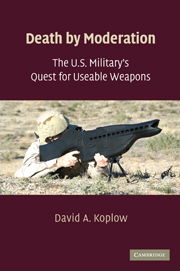Book contents
- Frontmatter
- Contents
- Preface
- Acknowledgments
- Abbreviations and Acronyms
- 1 Revolutionary Weapons and Transformed War
- 2 Deterrence and Self-Deterrence
- 3 The Law of Armed Conflict
- 4 Precision-Guided Munitions
- 5 Low-Yield Nuclear Weapons
- 6 Smart Antipersonnel Land Mines
- 7 Antisatellite Weapons
- 8 Nonlethal Weapons
- 9 What to Do about Useability
- Index
- References
5 - Low-Yield Nuclear Weapons
Published online by Cambridge University Press: 05 June 2012
- Frontmatter
- Contents
- Preface
- Acknowledgments
- Abbreviations and Acronyms
- 1 Revolutionary Weapons and Transformed War
- 2 Deterrence and Self-Deterrence
- 3 The Law of Armed Conflict
- 4 Precision-Guided Munitions
- 5 Low-Yield Nuclear Weapons
- 6 Smart Antipersonnel Land Mines
- 7 Antisatellite Weapons
- 8 Nonlethal Weapons
- 9 What to Do about Useability
- Index
- References
Summary
Scenario 5
Relations between the United States and the People's Republic of East Chuan have gone from terrible to worse. Decades after the brutal civil war that serrated the east and west halves of the Chuan peninsula into independent, mutually suspicious states, no lasting peace accord has been reached and irredentist sentiments on both sides of the still-tense demilitarized zone perpetually generate nasty border incidents and a genuine fear of renewed hostilities.
The United States ally, West Chuan, has developed into a functioning democracy, reasonably prosperous and stable. In contrast, East Chuan has retrogressed into a xenophobic dictatorship, a hermit fiefdom, isolated from international commerce and the civilizing influences of globalism. Worse, East Chuan has vigorously pursued every form of modern weaponry; although its exact capabilities remain a tightly guarded state secret, United States intelligence estimates that the East Chuanese have stockpiled functioning arsenals of both chemical and biological weapons (CW and BW). With the burgeoning threats of proliferation and terrorism now at the top of the international agenda, East Chuan is suspected of industriously selling its unconventional weapons expertise on the international black market, including perhaps offering CW and BW devices to nonstate actors intent upon wreaking havoc upon the United States and its allies.
Conventional aggression is also a live fear: In recent weeks, the saber-rattling from the East has increased in intensity, troops have been mobilized, weapons have been placed on alert, and the rhetoric has turned increasingly bellicose. Any full-scale attack from East to West Chuan would be disastrous today – the capital cities of the two regimes are barely 200 kilometers apart, and heavily urbanized development would expose millions of civilian residents to the worst ravages of modern combat.
- Type
- Chapter
- Information
- Death by ModerationThe U.S. Military's Quest for Useable Weapons, pp. 104 - 131Publisher: Cambridge University PressPrint publication year: 2009



